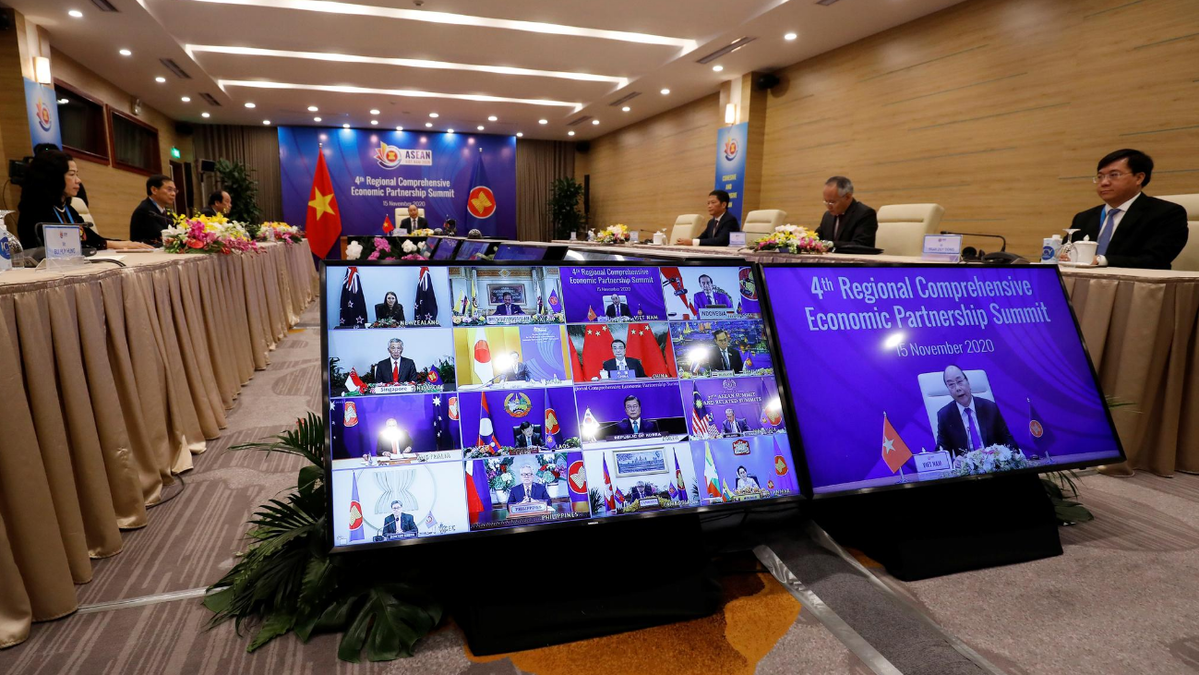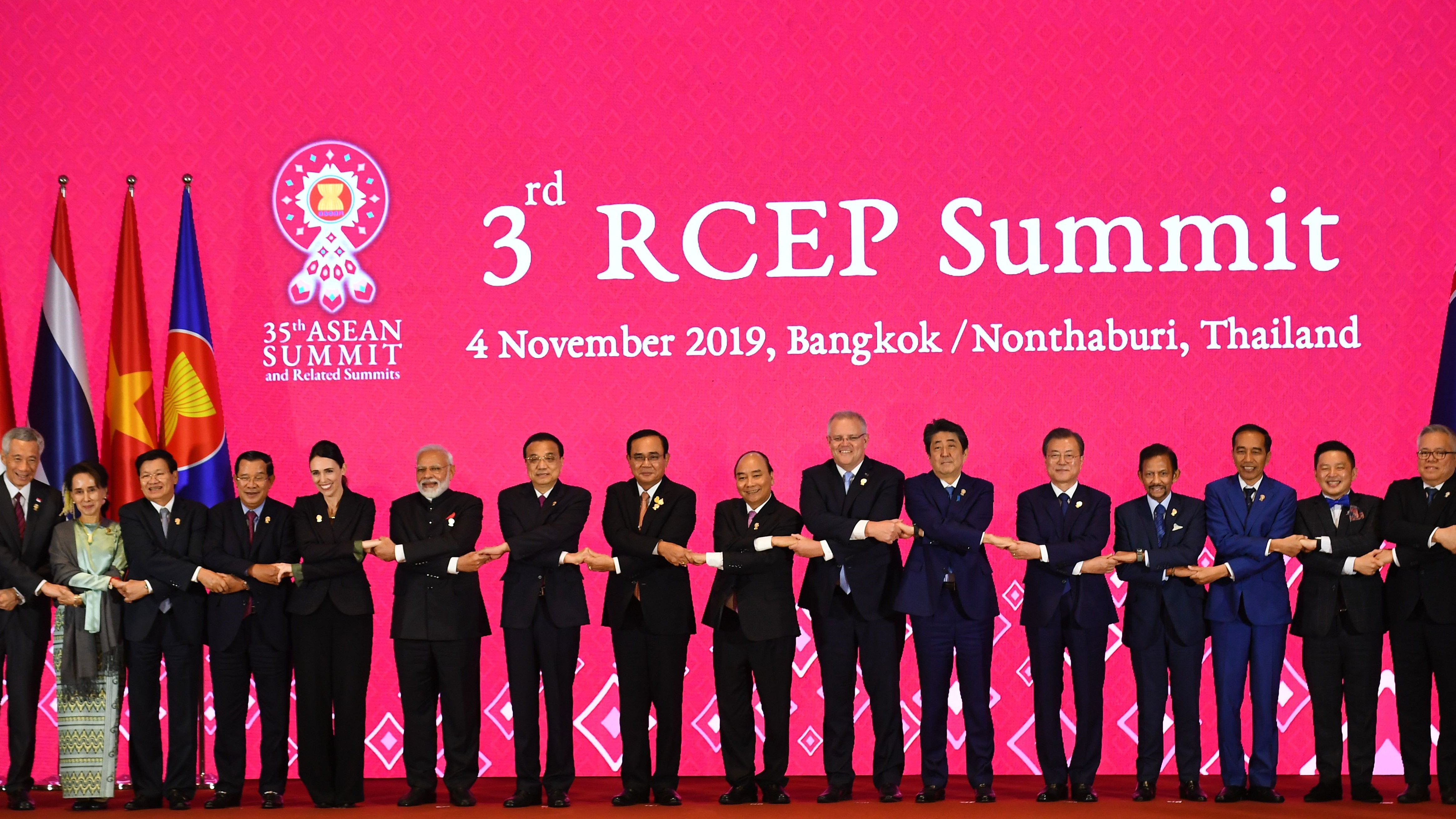With protectionist measures on the rise, the WTO largely sidelined, and a trade war between the two largest economies in the world continuing to drag on, any major initiative to reduce trade and investment barriers should be welcomed. And that is certainly the case with the Regional Comprehensive Economic Partnership (RCEP) which was signed over the weekend at a virtual gathering in Vietnam after eight long years of negotiation.
The massive accord brings together the ten member nations of ASEAN along with China, Japan, South Korea, Australia, and New Zealand. India was originally part of the pact but decided to drop out in 2019. RCEP members account for roughly 30% of global trade and GDP, making it the largest free trade agreement (FTA) in the world. RCEP will reduce tariffs and other barriers and establish rules in roughly 20 trade and investment-related areas.
An impressive accomplishment indeed. But despite its evident upsides, RCEP is not going to be a game changer. Consider the following:
FTAs already in place
Long before RCEP, FTAs already existed among most RCEP members. The ASEAN FTA and the ASEAN Economic Community had already opened trade and investment between the ASEAN members. And China, Japan, South Korea, Australia, and New Zealand already have FTAs in place with the ASEAN block. While this does not mean that RCEP is superfluous, it does suggest that a large portion of the trade liberalization that is viable among the 15 members has already been reaped.
To be clear though, RCEP will be the first FTA between some members, for example Japan and South Korea. But the amount of additional market opening that will take place between, for instance, Indonesia and Vietnam, where trade agreements are already in place, is negligible.
To the extent however that RCEP simplifies procedures (such as through a common rule-of-origin) or minimizes red tape, thereby allowing more SMEs to participate in trade, it should be applauded. FTA utilization rates in the SME-dominated region are abysmal – by some estimates, roughly 25%. But while progress in boosting SME uptake is welcome, the gains are unlikely to be overwhelming.
And even on tariff cutting, the bar was not set exceptionally high. For example, duties on roughly 39% of ASEAN’s food exports will not be removed. And for those hoping the agreement would substantially open Japan’s agricultural market, tariffs will remain in place for rice, wheat, beef, pork, dairy, and sugar.
The upshot? Depending on one’s precise definition, referring to RCEP as a “free” trade agreement might arguably be stretching things a bit.
Although regional agreements by definition cover a relatively small number of nations, they can have an out-sized impact by blazing the trail on otherwise intractable trade issues. Past experience suggests that other nations will frequently “follow the leader” – either by including similar provisions in whatever bilateral or regional agreements they may embark upon or by simply joining the ground-breaking agreement themselves.
In this way, by acting as pathfinders, regional accords can ultimately deliver benefits beyond their limited membership. Although RCEP does contain provisions on at least some of these “new” trade issues (such as e-commerce), it has not significantly advanced the ball or broken much new ground. And while the CPTPP has the “welcome mat” out for new members, India would be the only new member able to accede to RCEP, at least initially.
But with RCEP now signed – while the US has long since dropped out of TPP – at least some will read it as a “victory” for Chinese preeminence in East Asia and a marker of the further diminution of US influence. It remains to be seen if such perceptions could help push the Biden administration to consider re-entry into what is now known as the CPTPP.
RCEP positive, but unlikely to drive regional trade
Supporters of open trade and investment should welcome RCEP, especially for the encouraging signal it sends at a time when the cause of trade liberalization is on its back foot. The power of its example might jolt other countries into action and that alone would be a net gain.
But be realistic about expectations. Politicians (and others with vested interests) are notorious for over-selling free trade agreements and the results of this habitual over-hyping are uniformly counterproductive. Keep things in perspective. Ten years from now, as economists review the evolution of trade in East Asia during the preceding decade, RCEP will be a positive footnote. It is unlikely however to have driven the narrative.
© The Hinrich Foundation. See our website Terms and conditions for our copyright and reprint policy. All statements of fact and the views, conclusions and recommendations expressed in this publication are the sole responsibility of the author(s).









